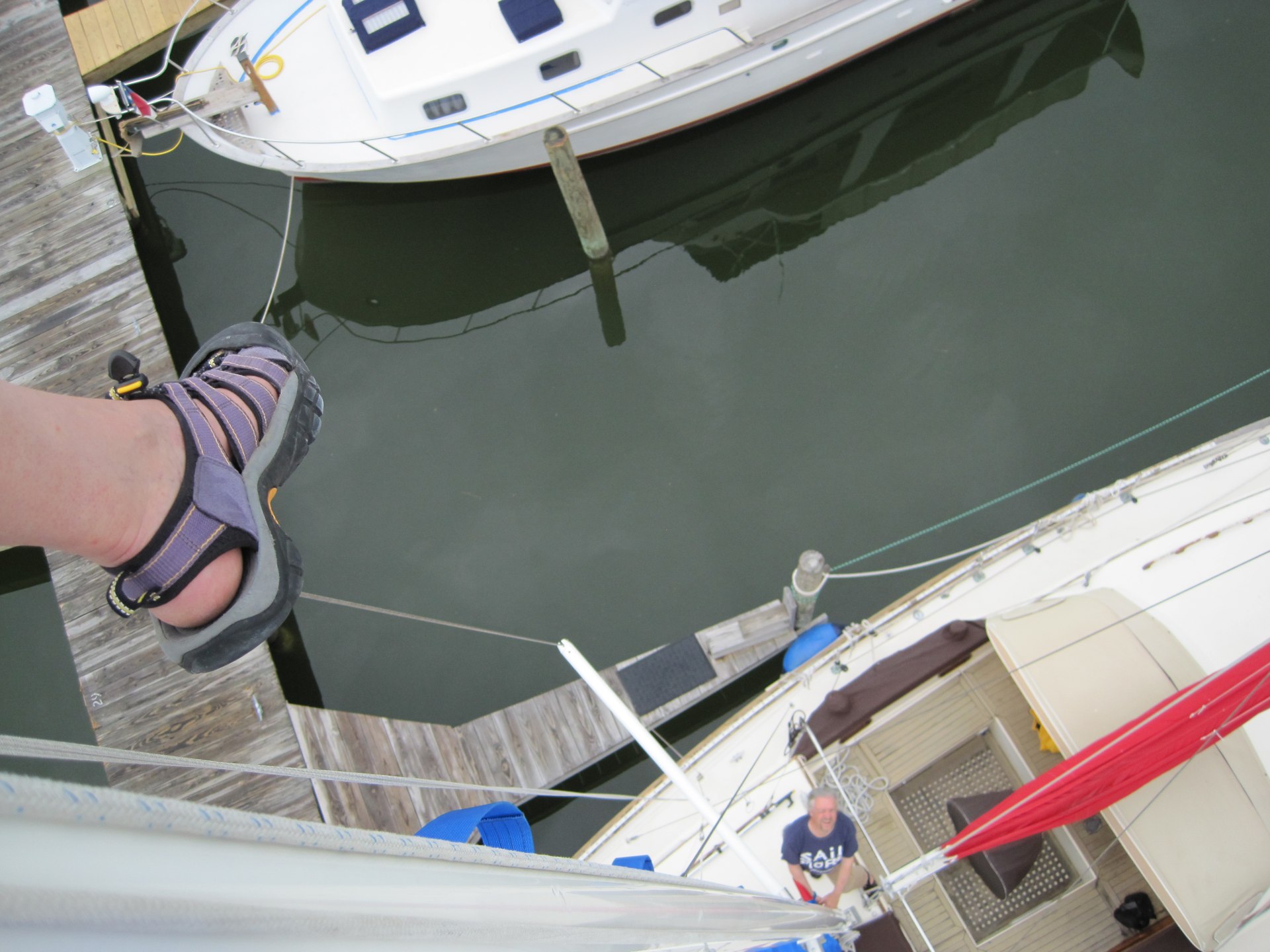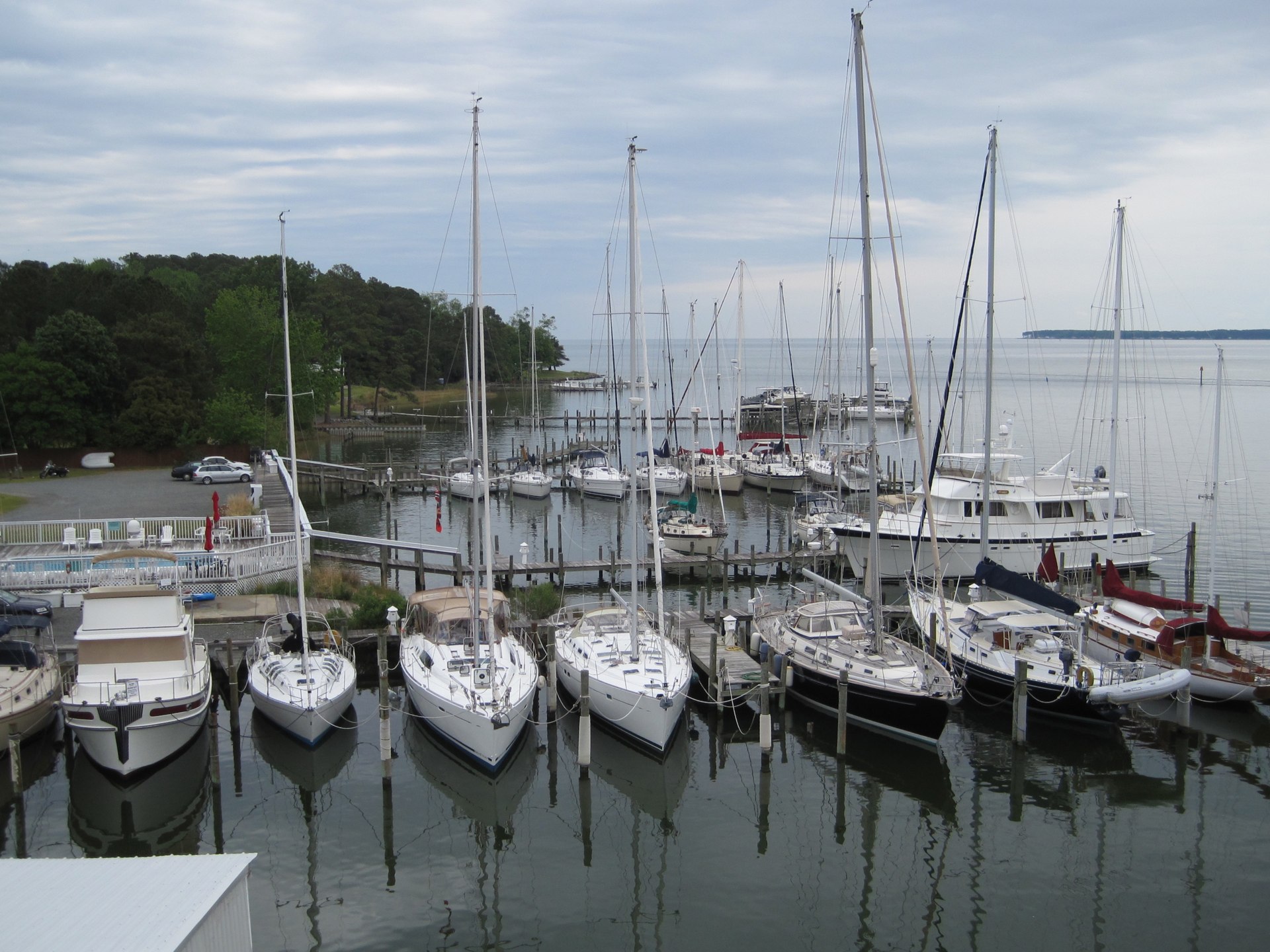Our first Mother's Day treat was a big breakfast in the picnic porch with the crew of Fawkes and Sea Turtle. Pancakes. Waffles. Syrup. Strawberries. Coffee. And some post-breakfast yarning about boats, sailing and life afloat. Important lesson: it's okay to motor-tack your big old ketch in light airs. Also, don't trust your chartplotter: look around. With your eyes.
After a great breakfast, we tried to tackle two jobs. One was more fun, one was much less fun. The fun factor seems to stem from the level of "done" we can achieve. Generally, not done means not fun.
Getting to [✔] Done
Here are some great views from the top of the mizzen.
The reason for going aloft was that we found some "stuff" on the deck. Part of a dense, slippery plastic washer. CA went aloft ("Rig Inspection") to look for a cause, but didn't spot anything obvious.
After looking at catalogs and technical specifications for mastheads, I realized that we hadn't looked everywhere in the masthead for the possible source of this plastic debris.
The second of CA's Mother's Day treats was to climb the mizzen. Three times. I didn't know what measurements I needed until after she got back down. Meh.
We're pretty sure that what we're seeing are pieces of some old "side plates" that were inserted on either side of the masthead sheave to reduce friction or fill the voids. Most likely for use with skinny (and damaging) wire rope halyards.
While there are some references to such things online, there don't seem to be any replacement parts. Even from RigRite, which seems to have everything. Here's the modern diagram of a masthead configuration. Nothing other than the essential sheaves. No collars or side plates.
Maybe we just don't need these for our ⅜" rope halyards? Maybe that job is [✔] Done?
Half-Baked Tank Ideas
We have an ongoing fuel issue. We're learning a lot about our engine and how to work with it. (See "Fuel System Hack".) We're hoping to learn even more.
The tanks have crud in them. There are a number of root causes:
-
Biology (algae mostly).
-
Water (condensation slowly accumulates water in fuel).
-
Vigorous agitation (i.e., a tornado).
Adding BioBor antibiotic to our fuel stops algae growth, but it also has the consequence of leaving dead goo floating through the filters. Another potential problem is adding ethanol to diesel fuel: extra alcohol will knock gunk off the sides of the tanks. It's a problem for gasoline engines—"Growing Concern over Ethanol"—less so for diesel.
While the tanks need to be cleaned, we'd like to hold off until next year's haul-out. We have 75 gallons of fuel which we'd like to use rather than dispose of. There are a lot of "Good Money After Bad" possibilities in that decision. As we noted, other sailors suggest that having a lot of filters on hand is cheaper than polishing or disposing of old fuel. $525 to dispose of the fuel or 50 filters to use the fuel?
Not [✔] Done Yet
We thought we might shave a few hours off the diesel mechanic's time. Our third mother's day treat was to remove the piece of flooring in front of the engine that blocks access to the center fuel tank. Removing this flooring requires removing the refrigerator compressor from the engine and removing the bracket that holds up the compressor.
How hard can it be?
The compressor was not too hard to remove. Two fan belts. Four bolts. Two wires for the electric clutch. [✔] Done. There it sits, perched insultingly on top of the Cantankerous Mr. Lehman.
The bracket could be left bolted to the floor board, but had to be unbolted from the fiberglass structure of the hull. It required heroic bending and reaching to get a wrench on the deeply-buried—almost inaccessible nuts in the frame. Nuts removed. ** [✔] Done**.
Removing the floor, however, requires more skills than we have. We got most of the deeply-buried square drive screws out, but the floor still would not budge. Did not move at all. It appears that the floor is fiberglassed in to the engine compartment from underneath. To me, it appeared to require a saw to remove it in pieces.
Space is confined. There are rubber hoses underneath the floor. I was befuddled. Not [ ] Done.
I'm waiting to find out what approach the boatyard pros use to remove something as intransigent as a fiberglassed board that has rubber hoses under it. In addition to new fuel tank plumbing, I hope to learn some additional lessons in boat maintenance techniques.
There's a lot to learn. That was our fourth mother's day treat. Learning some more of our limitations and where we need to grow our knowledge and skills. A far horizon is an exciting thing.






